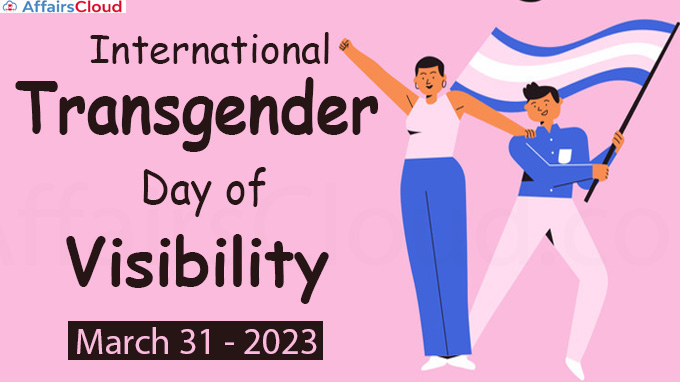 International Transgender Day of Visibility is annually observed across the globe on March 31 to celebrate the achievements and contributions of transgender and gender-diverse people (TGD) around the world.
International Transgender Day of Visibility is annually observed across the globe on March 31 to celebrate the achievements and contributions of transgender and gender-diverse people (TGD) around the world.
International Transgender Day of Visibility 2023 was observed on 31st March 2023.
Aim:
The day aims to raise awareness of the work that still needs to be done to eliminate discrimination and other barriers to inclusion within all aspects of society.
Flag:
i. Transgender flag is a tricolour pride flag with five horizontal stripes in light pink, light blue, and white.
- The colour of the Transgender flag was proposed in 1999.
ii. It was designed by American trans woman Monica Helms to represent the transgender community, organizations, and individuals.
Background:
i. International Transgender Day of Visibility was founded by Rachel Crandall, the United States of America (USA)-based transgender activist in 2009.
Rachel Crandall is a psychotherapist and the executive director of Transgender Michigan, an organisation based in the US.
ii. The 1st ever International Transgender Day of Visibility was observed on 31st March 2009.
History:
International Transgender day was sparked by the brutal death of Rita Hester, a black transgender woman, on 8th November 1998. The day was marked to commemorate her demise.
Transgender:
The term “Transgender”, shortly known as “Trans” refers to someone whose gender identity, gender expression, or behaviour does not correspond to that which is typically associated with the sex to which they were assigned at birth.
- Gender identity- refers to a person’s inner sense of being male, female, or something else.
- Gender Expression- refers to the way a person communicates gender identity to others through behaviour, clothing, hairstyles, voice or body characteristics.
Some Challenges faced by Trans People:
i. Lack of Legal Protection- Legal protections for trans people from discrimination based on gender identity is frequently lacking.
- There is still no comprehensive federal anti-discrimination law that covers gender identity, so trans people may still be without redress if they experience discrimination when looking for housing or eating in a restaurant.
ii. Poverty- Trans people experience poverty at high rates, and these rates are substantially higher for transgender people of colour.
- Around 29% of trans adults live in poverty, as well as 39% of Black trans adults, 48% of Latinx trans adults and 35% of Alaska Native, Asian, Native American and Native Hawaiian or Pacific Islander trans adults.
India’s Effort to Support Trans:
i. Transgender Bill 2016:
- As per the transgender persons (Protection of Rights) Bill 2016, it prohibits discrimination against a transgender person, including unfair treatment or denial of service in relation to employment, education, healthcare, access to public goods and facilities, etc.
ii. In 2019, the 1st 30-member National Council for Trans People in India has been established by the Indian government to advise, monitor, and evaluate measures to protect the people of the transgender community.



